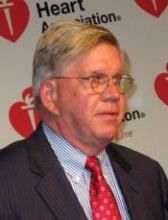ORLANDO – Adding extended-release niacin to raise HDL cholesterol levels in patients with stable coronary heart disease who are maintaining their LDL cholesterol below 70 mg/dL with intensive statin therapy doesn’t further reduce their cardiovascular event risk, according to the large National Institutes of Heath–sponsored AIM-HIGH trial.
But enthusiasm at the annual scientific sessions of the American Heart Association was low for AIM-HIGH, despite its lofty name. Numerous critics pointed to study design flaws they said render the findings tough to interpret.
"This trial disturbs me greatly," said discussant Dr. Philip Barter of the Heart Research Institute in Sydney.
"Whatever conclusions are drawn from this trial, it cannot be emphasized too much that [the trial] has not tested the HDL hypothesis, nor was it powered sufficiently to test the potential benefits of adding niacin to statins," he added.
The AIM-HIGH trial (Niacin Plus Statins to Prevent Vascular Events) involved 3,414 patients with stable coronary artery disease and low HDL cholesterol levels who were placed on 40-80 mg/day of simvastatin supplemented as necessary by 10 mg/day of ezetimibe in order to maintain an LDL cholesterol level of 40-80 mg/dL.
Participants were randomized to 1,500-2,000 mg/day of extended-release niacin (Niaspan) or placebo to see if niacin plus simvastatin reduced cardiovascular events to a greater extent than did the statin alone. The primary end point was a composite of MI, ischemic stroke, death due to coronary heart disease, hospitalization for an acute coronary syndrome, or symptom-driven revascularization.
Niacin produced the anticipated favorable lipid changes: a 25% boost in HDL cholesterol at 2 years from a baseline median of 35 mg/dL, a 29% drop in triglycerides, and a 12% decrease in LDL cholesterol from a baseline of 74 mg/dL.
Yet AIM-HIGH was stopped early on the grounds of futility: After a mean 3 years of follow-up, the rate of the primary end point was 16.4% in the niacin group and nearly identical at 16.2% in controls.
"I think the take-away message from the study would be that if you – as a patient with stable, nonacute cardiac disease – are able to achieve and maintain the levels of LDL we got in this study (that is, in the 60s), then there is not evidence from this trial to support continued use of niacin for the purpose of reducing clinical events," said Dr. William E. Boden, lead researcher and professor of medicine and public health at the State University of New York at Buffalo.
Dr. Barter wasn’t buying it.
"I totally disagree with that interpretation," he said. "I do not believe that we should draw any conclusions or change clinical practice on the basis of this underpowered study. We really must not overreact to a trial that had no ability to answer the question."
"Fortunately, the value of adding niacin to effective statin therapy is currently being investigated in the very much larger [HPS2-THRIVE (Heart Protection Study 2 – Treatment of HDL to Reduce the Incidence of Vascular Events) trial] that has randomized more than 25,000 participants. Within the next 12-18 months we’ll have that result. If that study doesn’t show a positive effect, niacin is finished. But to prejudge that before we’ve got the results of that trial and to stop patients from being treated on niacin is, I think, in the public health disinterest," Dr. Barter said.
A major problem with AIM-HIGH, according to Dr. Eliot Brinton, was the investigators’ decision to incorporate 150-200 mg/day of immediate-release niacin into the placebo tablets so the control group would experience niacin-induced flushing and thus wouldn’t be able to tell which study arm they were in.
That decision may explain the average 9.8% increase in HDL cholesterol seen in the control arm. As a result of this unanticipated rise in HDL, the difference in HDL levels between the two study arms was a mere 4 mg/dL, which could account for the closely similar outcomes in the two groups.
"My suggestion, with all due respect to the people who worked very hard on AIM-HIGH, is that we not try to draw clinical conclusions based on this study that was, in many ways, rather complicated," said Dr. Brinton of the University of Utah, Salt Lake City.
"I do not believe that we should draw any conclusions or change clinical practice on the basis of this underpowered study."
Niacin has multiple beneficial metabolic effects in addition to being the most effective HDL-raising agent approved at present. It reduces levels of the highly atherogenic lipoprotein (a), triglycerides, and LDL cholesterol, and – in combination with statin therapy – it has been shown in angiographic studies to cause atherosclerotic plaque regression. While awaiting the results of HPS2-THRIVE, clinicians might want to continue to offer niacin therapy to patients who appear to be at residual risk of events because of low HDL levels, despite effective LDL-lowering therapy, he suggested.


